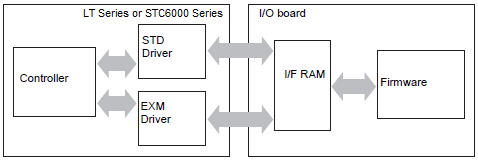
The I/O board sends the control order from the LT series or STC6000 series as shown in the following chart to control various I/Os. All orders and information on the I/O board are sent and received in I/F RAM.

![]()
The LT4000 Series includes the STD driver only.
I/O board processing
I/O board processing is mainly for refreshing I/O data and controlling the special I/O upon the LT request. These are processed via special I/O interrupt processing, 0.5 milliseconds fixed-cycle processing, 2 milliseconds fixed-cycle processing, and always-on processing. The priority of processing follows the order of special I/O interrupt processing, 0.5 milliseconds fixed-cycle processing, 2 milliseconds fixed-cycle processing, and then always-on processing.
For example, to execute special I/O interrupt processing while 2 milliseconds-fixed processing is being executed, 2 milliseconds fixed-cycle processing is stopped in order to execute special I/O interrupt processing.
|
Processing |
Items |
Details |
|
Special I/O interrupt |
Special I/O unique processing |
(Counter synchronize output control) |
|
(Counter preload input processing) |
||
|
(Counter strobe input processing) |
||
|
(2-phase counter marker input processing) |
||
|
(Acceleration/Deceleration pulse table switching) |
||
|
0.5 millisecond fixed-cycle |
Input terminal state storing |
|
|
2 millisecond fixed-cycle |
Standard I/O refresh |
|
|
Special I/O control watch |
Special I/O start/stop |
|
|
Special I/O parameter change watch |
Various special I/O parameter change |
|
|
(Special I/O counter input request watch) |
(Counter value clear) |
|
|
(Synchronize output clear) |
||
|
(Counter value read) |
||
|
(Counter value write) |
||
|
Special I/O unique processing |
Output pulse count update |
|
|
Existing host watch |
|
|
|
Normal Scanning (Always-on) |
Control register watch |
STD Driver
|
|
Communicating with EX modules |
|
To execute the processing for standard I/O only
The following is a reference that describes the transition of each process.
For convenience, each process uses the same processing time.
For Standard I/O, there is nothing that causes processing time to fluctuate.

To use special I/O
When you change the parameter while executing special I/O, the processing time of 2 milliseconds fixed-cycle changes. If the processing time of 2 milliseconds fixed-cycle increases, it affects the normal scan time and consequently the normal scan time increase.

Interrupt processing
When using special I/O that interrupts other processing, you can execute the special I/O interrupt processing at any time. Since the special I/O interrupt processing affects all other processing time, those processing times also increase.
